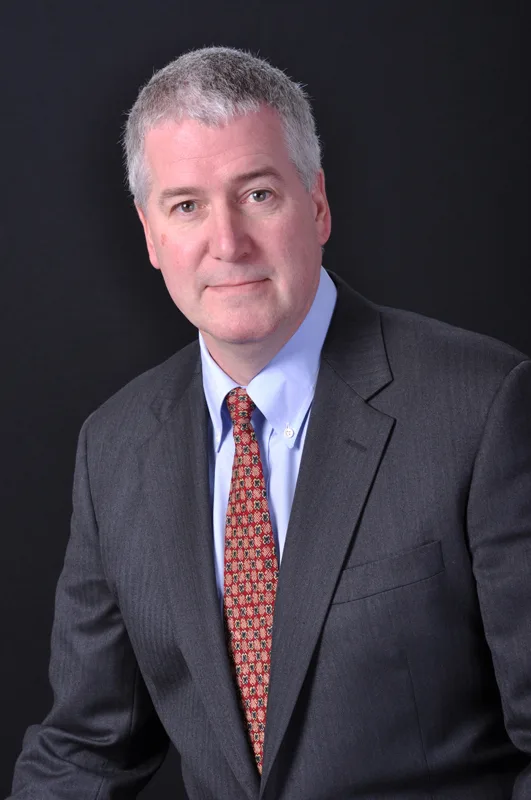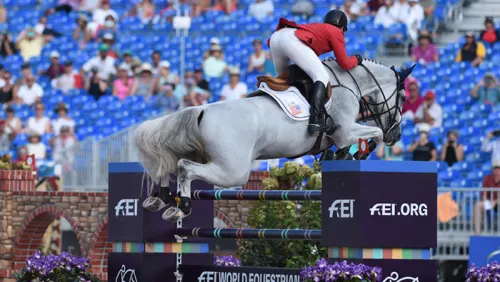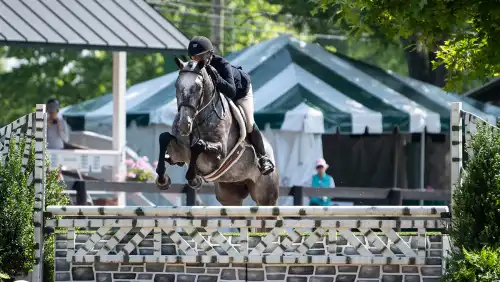If you’re driving down the road with new U.S. Equestrian Federation President-Elect Tom O’Mara, be prepared to discuss what you notice on the side of the interstate. Whether it’s an overgrown, no-longer-in-operation gas station or a successful food chain, he can’t stop asking questions.
“My family always laughs at me when they drive in the car with me,” said O’Mara. “I look at things along the side of the road, and I’m always trying to figure out, ‘What can you do with that?’ or, ‘How does that work?’ If it looks like a successful thing I’m driving by, it’s like, ‘Oh, that’s really cool.’ Or if I drive by an abandoned warehouse, I’m always like, ‘What can we do with that?’ I look at things that are working well and learn from them, and I look at the things that aren’t going well and see what you could apply.
“Like right there, there’s a hotel furniture outlet all boarded up right now,” he continued as he talks to me while driving the nine hours to his home in Ocala, Florida, after several days of meetings in Lexington, Kentucky.
But these musings aren’t limited to the road.
“I worked on Wall Street for 30-plus years. I think of things, oftentimes problems, and try to create solutions from a financial perspective,” said O’Mara, who worked as an investment banker specializing in trade derivatives. “We compared companies against companies, industries against industries, products against products, and we made relevant evaluation judgments. [It is] just kind of in my DNA; I’m always looking by comparing—whatever the environment is.”
O’Mara brought these skills to the horse show world, first as a show dad to kids Casey, Abby, Meg and TJ O’Mara and horse show husband to wife Liz O’Mara, and then to the collegiate level as he served on the National Collegiate Equestrian Association national advisory board as a co-chair. For the U.S. Equestrian Federation, Tom’s led the Drugs and Medications/Lab Review Task Force and served on the Competitions Task Force. He’s been on the USEF board of directors for the last four years, working as secretary/treasurer for the past two.

Meet new USEF President Tom O’Mara (center) with family (from left) Meg, Casey, Liz, Abby and TJ. Photo Courtesy Of Tom O’Mara
On June 22, he was elected president of USEF. His term will begin in January 2021. The Chronicle caught up with Tom to ask questions ranging from the serious to the funny.
Why did you go beyond the typical “horse show dad” role and get involved in governance?
Their passion became my passion. I’ve been a horse show dad for 20 years. [I’ve] walked around horse shows; I subscribed to every magazine; [I’ve] been involved in governance; I’ve gone to horse shows, conventions, symposiums, clinics, barns. I’ve watched; I’ve watched; I’ve watched.
The reason I did it in such a big way is twofold. One, my entire family did it, so my wife and my four children were head over heels. We were fortunate that as a family we did this together.
And the second reason I went full heartedly into it is because people who know me know that’s how I do everything. When I get really interested in something, I become all consumed by it. I love sports, and I saw what this sport did for my family.
It was just a beautiful thing to watch, but I can see how [equestrian sport] created confidence and discipline in my children. It gave them an edge. They had to have certain skills, which to me are really important skills in life in general. It wasn’t just what it did for my family, for my wife and my kids—although that was my primary win—but I then saw what it did for all people.
Bringing the joy of horses to as many people as possible, that’s the vision of the USEF. When I read that for the first time four or five years ago, I was like, ‘Wow, I can help with that. I know how to do that.’ When they asked me to be on the board because I was trying to help with that on the collegiate level, I thought, “I’m a good problem-solver. At least I can analyze them.” It doesn’t mean I always have the right answer. But I can analyze and come up with a few options. And with a group of people, we can review those options and make our best decision on which way to move forward and try to solve a problem. Again, you’re not always going to be right, but you have to be able to analyze and really look at a variety of options. I like doing that. I like doing that in whatever I get involved with.
What other business ventures have you tried?
I started farming; we started doing all sorts of different things: soybeans, organic wheat. I was working with the cooperative on creating the highest protein hay possible. So my goal was to end up in the Kentucky Derby—I wanted to be in the winner’s circle not for owning a horse but for supplying the best hay for the horse that wins. It didn’t happen, but I worked on it for a while.
We were kind of the producer and a wholesaler. We did 33,000 bales of hay a year and 800 round bales on top of that. We sold to all sorts of people. We’re right up in the foothills of the Adirondacks; that farm was in a town called Westport, New York.
Not only was I making hay, but I was also making maple syrup. I was making all sorts of stuff. I was trying to sell that as well. I branded it, marketed it. A friend of mine who was a graphic designer at a big advertising firm made labels. I bartered. I gave him hundreds of gallons of maple syrup. He would do all the work for me.
What’s the last book you read?
ADVERTISEMENT
Right now, I’m reading Pete Rozelle’s biography. He was the commissioner of the National Football League. He was the man who oversaw the NFL and took it to where it is today. He’s a famous leader in sports in the United States.
Who has been the greatest influence on your life?
My father [Bill O’Mara]. My mother was very active in her three boys’ lives. She was a very active person. But my father was the figurehead. He was very conservative, this is the funny thing, a man of few words because my mother talked all the time—that’s why people say I got the gab from my mother—but he was a hard-working guy. He was straightforward, and he let me know. We were young; I understood finances.
He was great man. Worked hard. Super ethical. Worked with me on a lot of stuff. My father was so involved, and my mother, with their children in all of the sports—that kind of followed through to me. And I think that’s why I completely embraced whatever my kids were doing. My dad’s the guy who taught me to do that.

“When you look at other sports, it’s really interesting because there is a path to success and growing alternative sport, and those are some of the steps that I’d like to see us move toward in the future,” said Tom O’Mara. Photo Courtesy Of Tom O’Mara
What’s your life motto?
Worry about the downside, and the upside takes care of itself.
What qualities do you value most in a person?
Integrity and trust.
What’s your favorite movie?
“Scarface” and “It’s A Wonderful Life.”
What’s a random thing people wouldn’t know about you?
I collected financial history for many, many years. I have been a big collector over my life. Not of expensive stuff. I don’t spend a lot of money on collections. Just weird things—I have weird interests in things.
I collected paper money from the 19th century. I was the president of the Fractional Currency Collectors board in the United States. I went to the Smithsonian Institution. [They] had one of the biggest collections of it; they didn’t even know it. I notified them when I was doing research, and I got an invitation, so the Smithsonian invited me down to be the expert.
[On Wall Street with my boss,] whenever we would meet new clients he would say, “And Tom, by the way, he’s not just a great financier, he actually is the expert in 19th-century currency, and the Smithsonian calls him when they’ve got a question.” My poor kids, when they were little, I used to take them to paper money shows and coin shows.
[Then also] I went to the University of Chicago for graduate school, and it’s right on the Midway Plaisance, which is where they had the [World’s] Columbian Exhibition, so I was always very familiar with it. But what I found over the years, each week of the exhibition, there were different tickets printed, and they were beautiful tickets. I had a full collection of those. I had every one of the tickets to get into the 1893 World’s Columbian Exhibition in Chicago [for the World’s Fair].
What’s the best piece of advice you’ve ever received?
Keep trying but adjust when you need to. It’s always like you want to reach for the stars, but you’ve got to reassess and adjust when necessary.

Tom O’Mara comes with 30-plus years of experience on Wall Street. He’s pictured here during an interview with Maria Bartiromo for CNBC. Photo Courtesy Of Tom O’Mara
What’s your favorite book?
ADVERTISEMENT
[James M. McPherson’s] “Battle Cry Of Freedom.” I’m kind of an amateur historian also. I really like American history.
What has been your favorite vacation?
Lake Placid [New York]—those are our greatest memories.
What three items do you always have in your refrigerator?
Eggs, cheese and a cold beer.
Where do you want to be in 10 years?
I immediately thought “above ground.” I enjoy life; whatever I’m doing is going to be great. I love new challenges. New things to learn about. I guess that would be one of the words to describe me: inquisitive.
What are some things you’d like to explore as USEF president?
Growing a fan base is really important to any sport, and that I am very much committed to. A lot of that came about by work with colleges.
I’ve been examining it and studying it for years now—all sports—and I see what the differences are between those sports and our sport. When I see that difference, [I ask,] “Is it a good difference or a bad difference?” and, “Is it something that we could close the gap on or adopt within our sport to help it get in front of more people?”
Not as many people are really as familiar with our sport as they are with a lot of other sports. And that’s because our sport is participant-driven.
If we look at it structurally, there’s not as much awareness because it’s not on television. People don’t travel to horse shows just randomly to watch events—they do some, but not broadly.

“Growing a fan base is really important to any sport, and that I am very much committed to,” said Tom O’Mara, pictured with Beezie Madden during the 2020 U.S. Equestrian Federation Annual Meeting. Photo Courtesy of USEF/Adam Brennan Photo
In examining other sports, here is what my response to people has been for the last couple of years: The No. 1 watched sport on television in the United States is football. And 99 percent of men stop playing when we’re about 13 years old because we end up not being big enough or fast enough to play at the higher levels, and there’s no organized football for women when they’re young at all. Yet it is the No. 1 watched sport in America on television. None of us play it. Women watch it as much as men, by the way. You don’t have to do this sport to want to watch it.
Two, the No. 1 watched sport in person in the United States is NASCAR. Those cars cost a lot more than our horses, even our best horses—even ridiculous prices for horses. So yes, that’s a very expensive sport, and I don’t see people running around saying it is an elitist sport. I think what [people] mean is that it is expensive, so to me I don’t call that elitist. There are 150,000 people sitting in those stands watching those races.
Is our goal as a sport to get everyone in America to ride a horse? Or is our goal to get everyone in America to watch someone ride a horse?
When you look at other sports it’s really interesting because there is a path to success and growing alternative sport, and those are some of the steps that I’d like to see us move toward in the future.
[At USEF] we do have a long list of things people would like more of. There are a lot of programs and services that are provided to our members, and more so now than four years ago. More so than in any point in time in the history of the sport really. But there’s obviously lots more to do. Now, whenever we see all these great opportunities, what is the biggest constraining factor in just doing them all? And that’s resources on a financial side.
I do believe there are many things that we could explore and new initiatives that might be potentially new sources of revenue for the organization. And again, not taxing the same exact people who already pay a lot of money to participate in this sport. But you go to other people. Other people who are just interested in the sport, and give them access to watch it or look at it or follow it, and charge them something so we can bring in more money, and then the money goes back to the participants of the sport.














